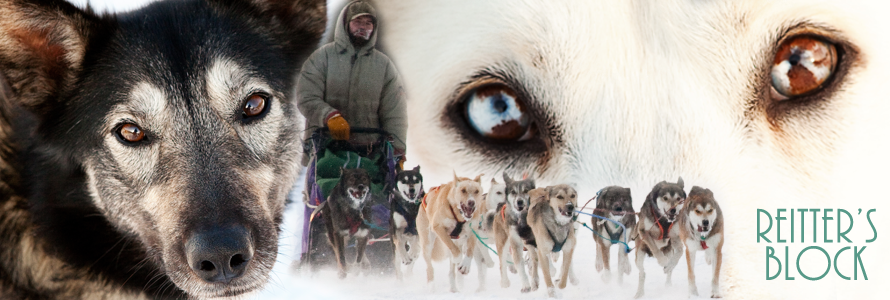 |
It's been a couple years since the last one of these. I still get asked a lot of the basics, but I want to try and make it more concise. To see the original, go here. This is a replay of some of those, but also some new tidbits.
The Iditarod Trail Sled Dog Race (the official full title of "The Iditarod") began when a group of mushers - led by Joe Reddington, Sr. - decided to "save the sled dog." With the introduction of airplanes and snowmachines/four wheelers to the state of Alaska, the jobs that were originally given to dog teams were going to the newer technologies. Reddington and his band of buddies were concerned that the lifestyle they loved would disappear forever. Reddington worked tirelessly to begin the world's first long distance sled dog race into existance.
| DeeDee Jonrowe's dog "Crush" at the start of the 2012 Tustumena 200. |
In 1973, Reddington's dream became a reality when the first Iditarod Sled Dog Race was held. It began the first weekend of March, and followed part of the historic Iditarod Trail and had long ago been used by trappers, goldminers and later the mail route (run by sled dogs). The race runs, mainly, along the same trail as the historic teams ran, but does not complete the entire trail. While Anchorage is the start of the race, Mile 0 of the Iditarod trail is actually in Seward, Alaska. To this day, the only Iditarod team to have traveled from Seward to Nome is 2004 Iditarod Champion Mitch Seavey's team when he ran his team from Seward the days before the start of the race in 2001.
In the early years, the race began in Anchorage's Tozier Track and travelled all the way to Nome. However, with the ever growing city's expantion in the late 70s and 80s, the race holds two starts; the Ceremonial Start in Anchorage (from 4th Avenue downtown to the Campbell Airstrip), and the restart at the Iditarod Headquarters in Wasilla. With Wasilla's growth and expansion, however, in the late 90s the restart was relocated to Willow where it starts from currently. Safety of the teams is first priority and with the growing vehicle traffic in the former cities, Willow was the best solution.
In 2003, due to a lack of snow in the South Central region, the race took a drasticly different route. It was the only year that Fairbanks hosted the start of the race. The teams took another historic route before connecting back to the Iditarod Trail. The race followed, basically, for the first and only time the famed Serum Run route to Nome. The Serum Run happened in 1925 when there was a Diptheria epedemic in Nome and the surrounding villages. Due to extreme weather, the newer technologies of transportation were unable to get the medicine the town so desperately needed. Teams of sled dogs planned a relay to get the medicine to Nome. A train transported the medication as far as Nenana where it was taken by dog sled. It took about six days to get to Nome, and the weather was horrendous. The average temperature was forty below zero, and the wind was so strong it was able to knock over dogs and sleds alike!
 |
| Leonhard Seppala & his lead dog Togo. Togo is the official mascot of the Iditarod Race. |
The Iditarod Sled Dog Race has two trails along the Yukon River, and alternates each year between the two. The Northern Route is run in the even years, and the Southern Route in the odd years. It's said that of the two, the Southern is more difficult because the wind generally comes at your face. The decision to have seperate courses was to allow more of the interior villages the chance to be featured and celebrate the race. The addition of the Southern route also allowed the race to go through the old gold rush town of Iditarod (now a "ghosttown" where only one structure somewhat remains). Iditarod is an Alaska Native word that means "A Great Distance." Iditarod (and Cripple for the Northern route) marks the halfway point of the race, and the first musher to make it into the checkpoint is rewarded with a plaque and $3000 in gold nuggets.
Because of the nature of the trail, and the fact that most of it is only put in for the purpose of the Iditarod Sled Dog Race (as well as the Iron Dog Snowmachine Race and the Iditarod Bike & Run), mileage differs slightly from race to race. The official mileage is 1,049miles (the 49 is a nod to Alaska's being the 49th state) but is normally closer to 1,200 miles when all is said and done. In 2012 it was decided that a major change to the race will occur. For only the second time, the Happy River Steps - feared by Rookies and intimidating to even the most seasoned veterans - will not be part of the race. A new trail was forged for a project in the area, and since its abandonment earlier this year the Iditarod Race Officials have glomped onto it. The reason cited is for the safety of the mushers and their dogs, which is the races' top priority. This change could be permanent.
Check back soon for part two of the series.





